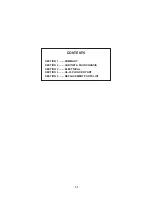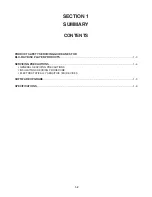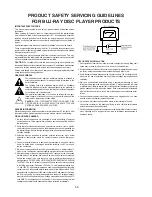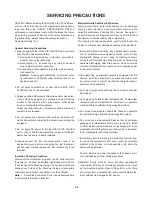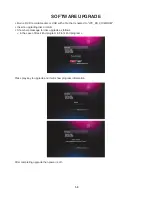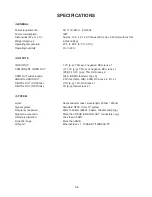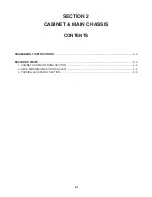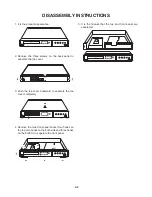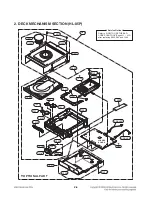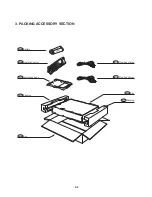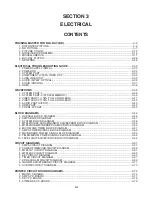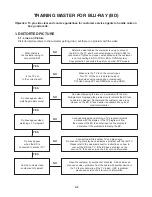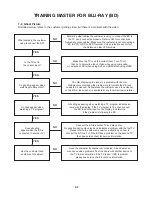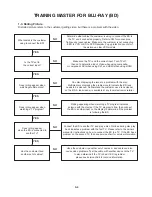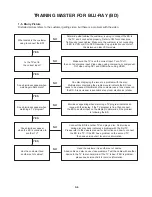
1-4
SERVICING PRECAUTIONS
caution: Before servicing the Blu-ray diSc Player cov
-
ered by this service data and its supplements and addends,
read and follow the SaFety PrecautionS. note: if
unforeseen circumstances create conflict between the follow
-
ing servicing precautions and any of the safety precautions in
this publications, always follow the safety precautions.
remember Safety First :
General Servicing Precautions
1. always unplug the Blu-ray diSc Player ac power cord
from the ac power source before:
(1) removing or reinstalling any component, circuit board,
module, or any other assembly.
(2) disconnecting or reconnecting any internal electrical
plug or other electrical connection.
(3) connecting a test substitute in parallel with an electro
-
lytic capacitor.
Caution : a wrong part substitution or incorrect polar
-
ity installation of electrolytic capacitors may result in an
explosion hazard.
2. do not spray chemicals on or near this Blu-ray diSc
Player or any of its assemblies.
3. unless specified otherwise in this service data, clean elec
-
trical contacts by applying an appropriate contact cleaning
solution to the contacts with a pipe cleaner, cotton-tipped
swab, or comparable soft applicator.
unless specified otherwise in this service data, lubrication of
contacts is not required.
4. do not defeat any plug/socket B+ voltage interlocks with
whitch instruments covered by this service manual might be
equipped.
5. do not apply ac power to this Blu-ray diSc Player
and / or any of its electrical assemblies unless all solidstate
device heat sinks are correctly installed.
6. always connect the test instrument ground lead to an
appropriate ground before connecting the test instrument
positive lead. always remove the test instrument ground
lead last.
Insulation Checking Procedure
disconnect the attachment plug from the ac outlet and turn
the power on. connect an insulation resistance meter (500v)
to the blades of the attachment plug. the insulation resistance
between each blade of the attachment plug and accessible
conductive parts (note 1) should be more than 1Mohm.
Note 1 : accessible conductive Parts include Metal panels,
input terminals, earphone jacks,etc.
Electrostatically Sensitive (ES) Devices
Some semiconductor (solid state) devices can be damaged
easily by static electricity. Such components commonly are
called electrostatically Sensitive (eS) devices. examples of
typical eS devices are integrated circuits and some field effect
transistors and semiconductor chip components.
the following techniques should be used to help reduce the
incidence of component damage caused by static electricity.
1. immediately before handling any semiconductor compo
-
nent or semiconductor-equipped assembly, drain off any
electrostatic charge on your body by touching a known
earth ground. alternatively, obtain and wear a commercially
available discharging wrist strap device, which should be
removed for potential shock reasons prior to applying power
to the unit under test.
2. after removing an electrical assembly equipped with eS
devices, place the assembly on a conductive surface such
as aluminum foil, to prevent electrostatic charge buildup or
exposure of the assembly.
3. use only a grounded-tip soldering iron to solder or unsolder
eS devices.
4. use only an anti-static solder removal device. Some solder
removal devices not classified as “anti-static” can generate
electrical charges sufficient to damage eS devices.
5. do not use freon-propelled chemicals. these can generate
an electrical charge sufficient to damage eS devices.
6. do not remove a replacement eS device from its protective
package until immediately before you are ready to install
it. (Most replacement eS devices are packaged with leads
electrically shorted together by conductive foam, aluminum
foil,or comparable conductive material).
7. immediately before removing the protective material from
the leads of a replacement eS device, touch the protective
material to the chassis or circuit assembly into which the
device will be installed.
caution: Be sure no power is applied to the chassis or cir
-
cuit, and observe all other safety precautions.
8. Minimize bodily motions when handling unpackaged
replacement eS devices. (normally harmless motion such
as the brushing together of your clothes fabric or the lifting
of your foot from a carpeted floor can generate static elec
-
tricity sufficient to damage an eS device.)
Summary of Contents for XV-BP1A
Page 13: ...2 6 MEMO ...
Page 54: ...3 41 3 Video Part 1 100 Full Color bar 7 9 10 8 11 14 CVBS_I 7 Y 8 Pb 9 Pr 10 ...
Page 56: ...3 43 5 AUDIO PART S PDIF 15 17 16 18 19 21 ASPDIF 15 ...
Page 57: ...3 44 6 HDMI PART 17 16 18 19 21 20 HDMI_SDA 16 HDMI_SCL 17 HDMI_CLK 18 HDMI_DATA 19 ...
Page 58: ...3 45 7 FRONT I F PART 21 20 T_TX 20 R_RX 21 ...
Page 59: ...3 46 BLOCK DIAGRAMS 1 OVERALL BLOCK DIAGRAM ...
Page 60: ...3 47 2 SMPS BLOCK DIAGRAM ...
Page 61: ...3 48 3 SYSTEM BLOCK DIAGRAM ...
Page 62: ...3 49 4 MT8520 DDR2 SDRAM NAND FLASH EEPROM BLOCK DIAGRAM ...
Page 63: ...3 50 5 MT8520 HDMI ETHERNET USB AV BLOCK DIAGRAM ...
Page 65: ...3 52 7 SMPS POWER SIGNAL BLOCK DIAGRAM ...
Page 66: ...3 53 8 MAIN BOARD POWER SIGNAL BLOCK DIAGRAM ...
Page 68: ...3 55 10 LEVEL SHIFTER CEC EFUSE BLOCK DIAGRAM ...
Page 69: ...3 56 MEMO ...
Page 71: ...3 60 3 59 2 POWER TIMER USB CIRCUIT DIAGRAM ...
Page 72: ...3 61 3 62 3 MT8520 1 CIRCUIT DIAGRAM ...
Page 73: ...3 63 3 64 4 MT8520 2 CIRCUIT DIAGRAM ...
Page 74: ...3 65 3 66 5 KEY CIRCUIT DIAGRAM ...
Page 75: ...3 67 3 68 6 TIMER CIRCUIT DIAGRAM ...
Page 76: ...3 69 3 70 7 DDR2 SDRAM CIRCUIT DIAGRAM ...
Page 77: ...3 71 3 72 8 NAND FLASH ETHERNET CIRCUIT DIAGRAM ...
Page 78: ...3 73 3 74 9 AV HDMI CIRCUIT DIAGRAM ...
Page 79: ...3 75 3 76 PRINTED CIRCUIT BOARD DIAGRAMS 1 MAIN P C BOARD TOP VIEW BOTTOM VIEW ...
Page 80: ...3 77 3 78 2 SMPS P C BOARD TOP VIEW BOTTOM VIEW ...
Page 105: ...4 24 MEMO ...
Page 106: ...4 26 4 25 CIRCUIT DIAGRAM ...
Page 108: ...4 29 4 30 PRINTED CIRCUIT BOARD DIAGRAMS TOP VIEW ...
Page 109: ...4 31 4 32 BOTTOM VIEW ...


